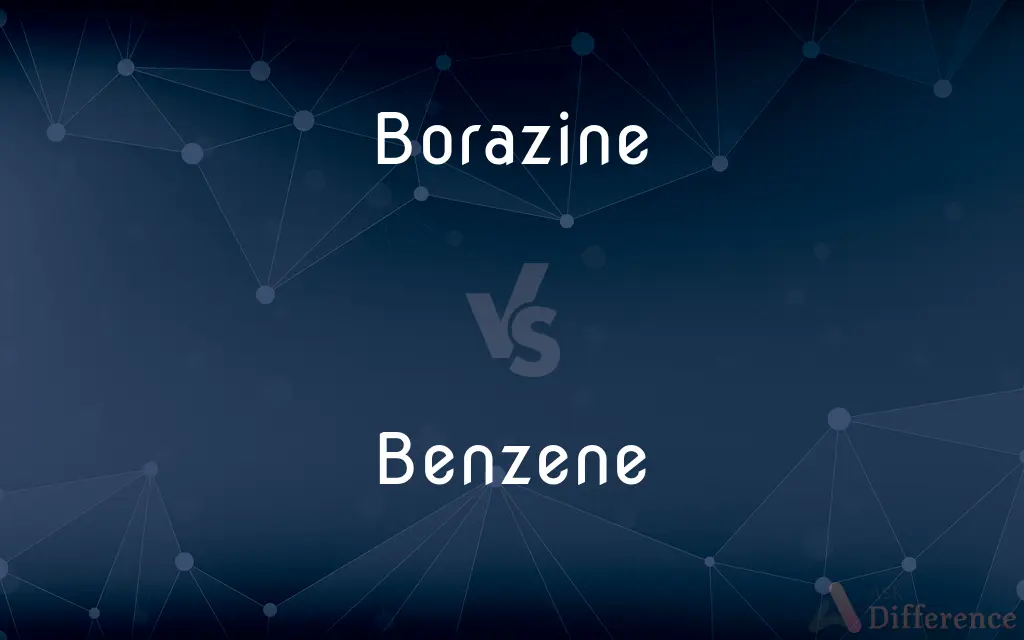Borazine vs. Benzene — What's the Difference?
Edited by Tayyaba Rehman — By Fiza Rafique — Updated on September 27, 2023
Borazine is an inorganic compound with the formula B₃N₃H₆, often termed "inorganic benzene", while Benzene is an organic aromatic compound with the formula C₆H₆.

Difference Between Borazine and Benzene
Table of Contents
ADVERTISEMENT
Key Differences
Borazine and Benzene are both cyclic compounds but differ significantly in terms of their molecular structure and properties. Borazine, often referred to as "inorganic benzene", consists of alternating boron and nitrogen atoms. On the other hand, Benzene is a purely carbon-based aromatic hydrocarbon, where six carbon atoms are connected in a planar ring.
In terms of chemical bonding, Borazine displays polar B–N bonds, resulting in a molecule that has a degree of ionic character. Contrastingly, Benzene has a system of delocalized pi electrons above and below its plane, which grants it stability and a distinct aromatic character.
Though Borazine has been likened to Benzene due to its ring structure, their chemical behavior differs. Borazine is less stable than Benzene and can hydrolyze in the presence of water, while Benzene is relatively unreactive under similar conditions.
The uses of Borazine and Benzene also diverge significantly. Borazine, being an inorganic compound, finds niche applications in high-temperature ceramics and as a precursor to boron nitride materials. Meanwhile, Benzene, as an organic solvent and a precursor to many important chemicals, holds immense industrial significance.
Comparison Chart
Molecular Formula
B₃N₃H₆
C₆H₆
ADVERTISEMENT
Type
Inorganic
Organic
Atomic Constituents
Boron and Nitrogen
Carbon
Chemical Bonding
Polar B–N bonds
Delocalized pi electrons
Reactivity
Less stable, can hydrolyze
Relatively unreactive
Compare with Definitions
Borazine
An inorganic ring compound with alternating boron and nitrogen atoms.
Borazine is often referred to as inorganic benzene due to its structural similarity.
Benzene
A common solvent and precursor in the chemical industry.
Many important industrial compounds are derived from benzene.
Borazine
A compound that displays polar B-N bonds.
The polarity in borazine can be attributed to the difference in electronegativity between boron and nitrogen.
Benzene
A potentially carcinogenic compound.
Prolonged exposure to benzene can have adverse health effects.
Borazine
A precursor to boron nitride materials.
High-purity borazine is used in the synthesis of boron nitride nanotubes.
Benzene
A molecule characterized by delocalized pi electrons.
The delocalization in benzene contributes to its stability and aromaticity.
Borazine
A molecule with a degree of ionic character.
Unlike benzene, borazine's bonds introduce an element of ionic character to the molecule.
Benzene
A six-membered ring consisting of carbon atoms and having a planar structure.
Benzene is one of the fundamental structures studied in organic chemistry.
Borazine
A cyclic compound hydrolyzing in the presence of water.
When exposed to moisture, borazine can decompose to produce boron, nitrogen, and hydrogen.
Benzene
An aromatic hydrocarbon with a distinct smell.
Benzene's aroma is often described as sweet or gasoline-like.
Borazine
Borazine, also known as borazole, is a polar inorganic compound with the chemical formula B3H6N3. In this cyclic compound, the three BH units and three NH units alternate.
Benzene
Benzene is an organic chemical compound with the molecular formula C6H6. The benzene molecule is composed of six carbon atoms joined in a planar ring with one hydrogen atom attached to each.
Borazine
(inorganic compound) A cyclic hydride of boron and nitrogen made by the reaction of diborane and ammonia; it is isoelectronic with benzene.
Benzene
A colorless, flammable, toxic, liquid aromatic hydrocarbon, C6H6, derived from petroleum and used in or to manufacture a wide variety of chemical products, including DDT, detergents, insecticides, and motor fuels. Also called benzol.
Benzene
(organic compound) An aromatic hydrocarbon of formula C6H6 whose structure consists of a ring of alternate single and double bonds.
Benzene
Sometimes used in place of the phenyl group.
Benzene
A volatile, very inflammable liquid, C6H6, contained in the naphtha produced by the destructive distillation of coal, from which it is separated by fractional distillation. The name is sometimes applied also to the impure commercial product or benzole, and also, but rarely, to a similar mixed product of petroleum.
Benzene
A colorless liquid hydrocarbon; highly inflammable; carcinogenic; the simplest of the aromatic compounds
Common Curiosities
Is Benzene hazardous?
Yes, Benzene is carcinogenic and should be handled with caution.
Can Borazine be used as a solvent like Benzene?
No, Borazine's properties and reactivity differ significantly from Benzene.
What's the significance of delocalized pi electrons in Benzene?
They grant Benzene stability and its characteristic aromaticity.
Why is Borazine less stable than Benzene?
The polar B-N bonds in Borazine make it more reactive compared to the stable pi system in Benzene.
Why is Borazine called "inorganic benzene"?
Due to its structural similarity to Benzene, though they differ chemically.
Is Borazine a common compound?
No, Borazine is a niche compound, primarily of interest in specific chemical contexts.
Are there derivatives of Borazine similar to Benzene derivatives?
Yes, there are analogs, but their properties and reactivities are distinct from those of Benzene.
Share Your Discovery

Previous Comparison
Prime vs. Premium
Next Comparison
Abridged vs. EditedAuthor Spotlight
Written by
Fiza RafiqueFiza Rafique is a skilled content writer at AskDifference.com, where she meticulously refines and enhances written pieces. Drawing from her vast editorial expertise, Fiza ensures clarity, accuracy, and precision in every article. Passionate about language, she continually seeks to elevate the quality of content for readers worldwide.
Edited by
Tayyaba RehmanTayyaba Rehman is a distinguished writer, currently serving as a primary contributor to askdifference.com. As a researcher in semantics and etymology, Tayyaba's passion for the complexity of languages and their distinctions has found a perfect home on the platform. Tayyaba delves into the intricacies of language, distinguishing between commonly confused words and phrases, thereby providing clarity for readers worldwide.














































